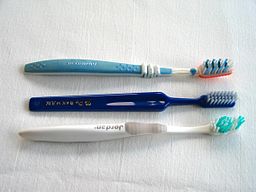In 1938, the first nylon-bristle
toothbrush in the U.S. was described in a New York Times business report. Dr.
West's Miracle-Tuft toothbrush, a new product from the Weco Products Company,
was the first to use synthetic DuPont nylon bristles instead of natural hog
bristles. It had four guarantees: “No bristle shedding, 100 per cent
waterproofed, longer life, greater cleansing power.” Its price was to be 50
cents (with a fair-trade minimum of 47 cents). The report said an intensive
national advertising campaign for the new toothbrush was to be launched in
about six weeks. Competition came in May 1939, as Johnson & Johnson began
advertising their new Tek toothbrush.
The predecessor of the toothbrush
is the chew stick. Chew sticks were twigs with a frayed end used to brush
against the teeth, while the other end was used as a toothpick. The earliest
chew sticks were discovered in Babylonia in 3500 BC, an Egyptian tomb dating
from 3000 BC, and mentioned in Chinese records dating from 1600 BC. The Greeks
and Romans used toothpicks to clean their teeth and toothpick-like twigs have
been excavated in Qin Dynasty tombs. Chew sticks remain common in Africa; the
rural Southern United States - and in the Islamic world the use of chewing
stick Miswak is considered a pious action, and has been prescribed to be used
before every prayer five times a day. Miswak has been used by Muslims since 7th
Century AD.
 |
| A selection of toothbrushes. By Jonas Bergsten, via Wikimedia Commons |
The first bristle toothbrush,
resembling the modern toothbrush, was found in China during the Tang Dynasty (619–907)
and used hog bristle. The bristles were sourced from hogs living in Siberia and
northern China because the colder temperatures provided firmer bristles. They
were then attached to a handle manufactured from bamboo or bone, forming a
toothbrush. In 1223, Japanese Zen master Dōgen Kigen recorded on Shōbōgenzō
that he saw monks in China clean their teeth with brushes made of horse-tail
hairs attached to an ox-bone handle. The bristle toothbrush spread to Europe,
brought back from China to Europe by travellers. It was adopted in Europe
during the 17th century. The earliest identified use of the word toothbrush in
English was in the autobiography of Anthony Wood, who wrote in 1690 that he had
bought a toothbrush from J. Barret. Europeans found the hog bristle
toothbrushes exported from merchants in China too firm, and preferred softer
bristle toothbrushes manufactured from horsehair. Mass-produced toothbrushes,
made with horse or boar bristle, continued to be imported to England from China
until the mid-20th century.
In Europe, William Addis of
England is believed to have produced the first mass-produced toothbrush, in
1780. In 1770, he had been jailed for causing a riot; while in prison he
decided that the method used to clean teeth – at the time rubbing a rag with
soot and salt on the teeth – was ineffective and could be improved. To that
end, he saved a small animal bone left over from the meal he had eaten the
previous night, into which he drilled small holes. He then obtained some
bristles from one of his guards, which he tied in tufts that he then passed
through the holes in the bone, and which he finally sealed with glue. After his
release, he started a business that would manufacture the toothbrushes he had
built, and he soon became very rich. He died in 1808, and left the business to
his eldest son, also called William, and it stayed in family ownership until
1996. Under the name Wisdom
Toothbrushes the company now manufactures 70 million toothbrushes per year in
the UK.
By 1840 toothbrushes were being mass-produced in England, France,
Germany, and Japan. Pig bristle was used for cheaper toothbrushes, and badger
hair for the more expensive ones.
The first patent for a toothbrush
was granted to H. N. Wadsworth in 1857 (US Patent No. 18,653) in the United
States, but mass production in the United States only started in 1885. The
rather advanced design had a bone handle with holes bored into it for the
Siberian boar hair bristles. Unfortunately, animal bristle was not an ideal
material as it retains bacteria and does not dry well, and the bristles often
fell out. In addition to bone, sometimes handles were made of wood or ivory. In
the United States, brushing teeth did not become routine until after World War
II, when American soldiers had to clean their teeth daily.
During the 1900s, celluloid
handles gradually replaced bone handles in toothbrushes. Natural animal
bristles were also replaced by synthetic fibers, usually nylon, by DuPont in
1938. The first electric toothbrush, the Broxodent, was invented in Switzerland
in 1954. As of the turn of the 21st century, nylon had come to be widely used
for the bristles, and the handles were usually molded from thermoplastic
materials.
Johnson & Johnson, a leading
medical-supplies firm, introduced the "Reach" toothbrush in 1977. It
differed from previous toothbrushes in three ways: First, it had an angled
head, similar to dental instruments, to reach back teeth; second, the bristles were
concentrated more closely than usual to clean each tooth of potentially
carigenic (cavity-causing) materials; and third, the outer bristles were longer
and softer than the inner bristles, to clean between teeth. The Reach
toothbrush was the first to have a specialized design intended to increase its
effectiveness. Other models, from other manufacturers, soon followed; each of
these had unique design features intended to be, and promoted as being, more
effective than the basic toothbrush design that had been employed for years.
In January 2003 the toothbrush
was selected as the number one invention Americans could not live without
according to the Lemelson-MIT Invention Index.
For more information, visit:-




